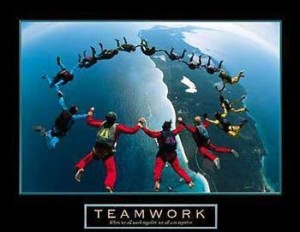 Motivation can have many effects on an athlete as an individual and a team as a whole. Depending on the type of motivational strategies used, a coach’s motivational strategies can have positive or negative effects. Truman (2003) identified how motivational techniques such as inspirational direction and bragging promoted more motivation on a team and, as a result, created team cohesion.
Motivation can have many effects on an athlete as an individual and a team as a whole. Depending on the type of motivational strategies used, a coach’s motivational strategies can have positive or negative effects. Truman (2003) identified how motivational techniques such as inspirational direction and bragging promoted more motivation on a team and, as a result, created team cohesion.
To expand on the notion of cohesion, Kenow and Williams (1999) bring to light the importance of players and coaches having similar goals, promoting team cohesion which ultimately leads to a team becoming successful. In order to achieve cohesion a team must share similar goals this promotes team cohesion and by doing so, players then motivate each other to attain the team’s desired goal. Jowett and Chaundy (2004) go on to state that there are multiple sources of evidence that prove a link exists between cohesion and sport performance. Jowett and Chaundy (2004) go on to further explore that cohesion deals with an athlete’s interpersonal connection with their fellow teammates. Jowett and Chaundy (2004) go on to say “how athletes themselves experience their relationship with the coach is more important than how coaches experience relationships with their athletes in the team” (p. 309). A relationship within a team is paramount for achieving success and optimal athletic performance.
Janssen (2002), outlines his Seven C’s of championship team building, listing cohesion as sixth. Janssen relates cohesion to success, saying “[c]ohesion within your team enhances communication, minimizes conflict, and provides you with an extra edge of motivation and commitment all because your players respect each other” (p. 137). This statement says it all: through cohesion a team can not only have the motivation to become successful, but can drive the individual athlete to perform at their best. The key to that cohesiveness is motivation to strive for the same goals and objectives.
Not only can motivation encourage team cohesion, but it can also deter it as Turman (2003) illustrates in his study. His research showed that when coaches use negative motivational strategies like inequity, embarrassment and ridicule, team cohesion was negatively affected. A team that has deficiencies in cohesion will not be motivated to perform to their maximum athletic ability. This can have adverse affects on the coach-athlete relationship which could lead to increased team dropout rates.
A major problem that is disheartening to an athletic program is high dropout rates among athletes. Having highly motivated athletes will combat high dropout rates and decrease them dramatically. To elaborate on the problem that coach’s face with dropout rate Boiché and Sarrazin (2009) discovered that a consistent factor of dropout was goal conflict. A conflict of goals by athlete and coach was found to be a significant cause of dropout. If the coach’s personal goals do not match the athletes’ goals, then there is less satisfaction, less commitment and the result is the athlete quitting the sport. Goal setting ties in with team cohesion. If a coach does not have an overall similar goal for the team itself, but has individual goals for each athlete, there will be motivation to compete as individuals and thus decrease chances of success as an overall team. With similar goals, a coach will have better impact when using motivation tactics and will increase team cohesion, athlete-coach relations and reduce dropout rates.
If there are misconceptions of goals and goals that are not mutual between coach and athlete, it can lead to self-handicapping behaviors for athletes. Ryska and Zenong (1999) define self-handicapping as “self-imposed performance obstacles which function to protect one’s self-esteem within achievement settings” (p. 410). The results of the study were that there is significant evidence that an athlete’s own motivational goals and perceptions of a team’s motivation are factors when trying to cope with competitive stress through utilization of self-handicapping strategies. Ryska and Zenong (1999) found that the best predictor of self-handicapping is team climate. Team climate is the motivational team environment that the athlete is exposed to. A coach must use various types of positive reinforcement and motivational techniques to improve athletic performance and team cohesion. They explain that an athlete’s motivational goals and the team’s motivation are important factors when coping with the competitive stress. When stress levels are down, it leads to better athletic performance and a decrease in dropout rate.
Coaches should also take into careful consideration what coaching style they utilize. Martens (2004) outlines three major coaching styles: command, submissive and cooperative. The command style of coaching is one that the coach is in charge and makes all the decisions. With this style it is assumed the coach has the most knowledge about the sport and whatever they say, the athlete will do; the athlete has no say in any decisions or any other function of the team. In other words, whatever the coach says goes. As Martens (2004) explains, “the athlete’s role is to listen, to absorb, and to comply” (p. 30). This coaching style is more geared toward the professional athletes where motivation is already established and players have matured. To the younger athlete this type of style can prove to be devastating to motivation of the individual and team. Stewart and Taylor (2000) add to this type of style and it’s adverse effects on motivation by explaining how an over emphasis on winning (which most coaches of this command style utilize), with a combination of reducing the emphasis on skills acquisition and the reducing the fun factor ultimately leads to an increase in dropout rate as stated previously.
The second coaching style is the submissive style, where the coach is seen as a baby-sitter. The coach makes very few decisions and provides little instruction to athletes. Martens (2004) goes on to explain that the reason coaches choose this style is due to their lack of sport knowledge. In a study conducted by Andrew (2009), if a coach provides athletes with a desired level of training and instruction, they will have the ability to influence their satisfaction and therefore increase athlete’s motivation. A submissive style of coaching would not provide the team or individual athletes with this desired level of instruction and thereby decrease motivation to excel at the sport.
The third and the most effective style of coaching to motivate athletes and teams is the cooperative style. Coaches that use this style have a good coach-athlete relationship, and they often share decision making with the team. Martens (2004) explained why this approach is the most effective out of all the three: “It promotes openness in the relationship between coaches and athletes, and it improves both communication and motivation” (p.34). This style is ideal for increasing motivation, team cohesion, and the result is an increase in athletic performance. To reinforce why a cooperative style of coaching is an ideal coaching style, Martin, Matthew M., Rocca, Kelly A., Cayanus, Jacob L., & Weber, Keith (2009) conducted a study where a volleyball coach utilized the command style of coaching on his athletes. This is what one athlete had to say about her response to command style coaching, “I was angry with the coach because I thought he’d let me down. I thought he should have given me some guidance…I just shut off from volleyball really” (Jacob et al., 2009 p. 285). The athlete’s response is typical of those coached under the command style, their motivation and drive to improve is quickly diminished and at times the athletes dropout and quit the sport. In this coaching scenario there was little positive feedback and a coach’s decisions were discussed with the athletes very little, thus communication is hindered and motivation is stifled.
Another important factor that the cooperative coaching style provides in increasing motivation is opening and establishing coach-athlete communication. As Janssen (2002), outlines his Seven C’s of championship team building and communication falls under number four. He goes on to explain that championship teams have clear and honest communication on and off the field/court. By doing so, a coach can understand their athletes and teams’ goals and objectives. A coach can also involve a team in formulating a team objective or goal for a single game or for an entire season. This builds a bond between the coach and athletes alike and taps into what drives and motivates the athletes you coach. Knowing the type of coaching style that works for you as a coach, and for your athletes, is important in the type of motivational strategies you use to enhance athletic performance and promote team cohesion.
Stay tuned to Sport Psychology Today for the remainder of this article and more information on Motivation, The Seven C’s of Championship Team building, and additional coaching techniques. Sport Psychology Today will be releasing this article “There is More to Motivation than Locker Room Speeches” by John Papasideris, in a four part series.
To learn more about the author you can visit his blog using the following link:
Headstrong Sports Consulting
Andrew, Damon P.S., (2009). The Impact of Leadership Behavior on Satisfaction of College Tennis Players: A Test of the Leadership Behavior Congruency Hypothesis of the Multidimensional Model of Leadership. Journal of Sport Behavior, 32(3), 261-277.
Barker, Scott (2002). The Personality Theory in Coaching. Coach and Athletic Director, 72(1), 11-12.
Boiché, Julie C. S., & Sarrazin, Philippe G. (2009). Proximal and distal factors associated with dropout versus maintained participation in organized sport. Journal of Sports Science & Medicine, 8(1), 9-16.
Cloninger, Susan (2004). Mischel and Bandura: Cognitive Social Learning. (4th ed.), Theories of Personality Understanding Persons (p. 367). New Jersey: Pearson Education Inc.
Janssen, Jeff (2002). Championship Team Building. Piershill Lane, NC: Winning The Mental Game.
Jowett, Sophia, & Chaundy, Victoria, (2004). An Investigation Into the Impact of Coach Leadership and Coach-Athlete Relationship on Group Cohesion. Group Dynamics: Theory, Research, and Practice, 8(4), 302-311.
Kassing, Jeffrey W., Pappas, Micah E. (2007). “Champions are Built in the Off Season”: An Exploration of High School Coaches’ Memorable Messages. Human Communication. A Publication of the Pacific and Asian Communication Association. 10(4), 537-546.
Kavussanu, Maria, Boardley, Ian D., Jutkiewicz, Natalia, Vincent, Samantha, & Ring, Christopher. (2008). Coaching Efficacy and Coaching Effectiveness: Examining Their Predictors and Comparing Coaches’ and Athletes’ Reports. Sport Psychologist, 22(4), 383-404.
Kenow, Laura., Williams, Jean M. (1999). Coach-Athlete Compatibility and Athlete’s Perceptions of Coaching Behaviors. Journal of Sport Behavior, 22(2), 251-259.
Martens, Rainer (2004). Successful Coaching (3rd ed.). Champaign, IL: Human Kinetics.
Martin, Matthew M., Rocca, Kelly A., Cayanus, Jacob L., & Weber, Keith (2009).
Relationship between Coaches’ use of Behavior Alteration Techniques and Verbal Aggression on Athletes’ Motivation and Affect. Journal of Sport Behavior, 32(2), 227-241.
Ryska, Todd A., Yin, Zenong (1999). The Role of Dispositional Goal Orientation and Team Climate on Situational Self-Handicapping Among Athletes. Journal of Sport Behavior, 22(3), 410-425.
Stewart, C., Taylor, J. (2000). Why Female Athletes Quit: Implications for Coach Education. Physical Educator, 57(4), 170.
Turman, Paul D. (2003). Coaches and Cohesion: The Impact of Coaching Techniques on Team Cohesion in the Small Group Sport Setting. Journal of Sport Behavior, 26(1), 86-104.
Vargas-Tonsing, Tiffanye M. (2009). An Exploratory Examination of the Effects of Coaches’ Pre-Game Speeches on Athletes’ Perceptions of Self-Efficacy and Emotion. Journal of Sport Behavior, 92-111.

























